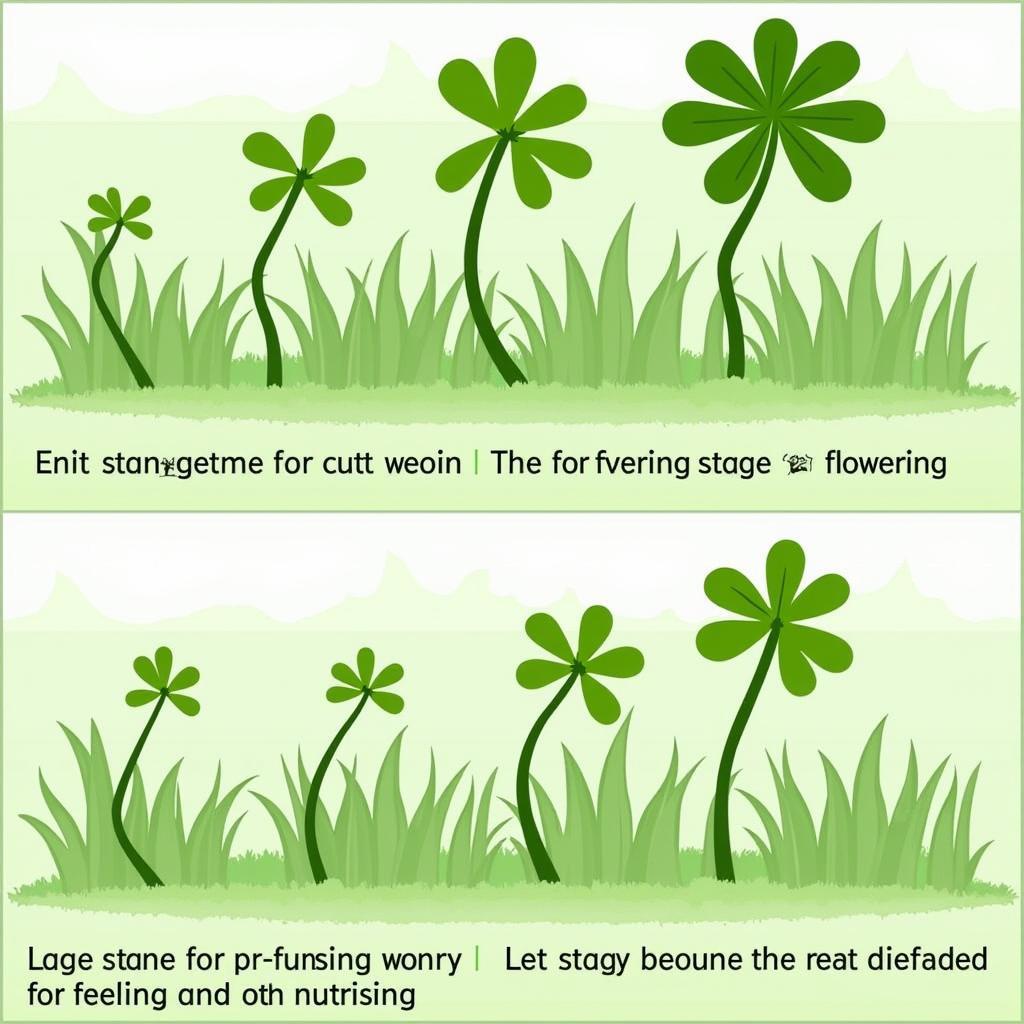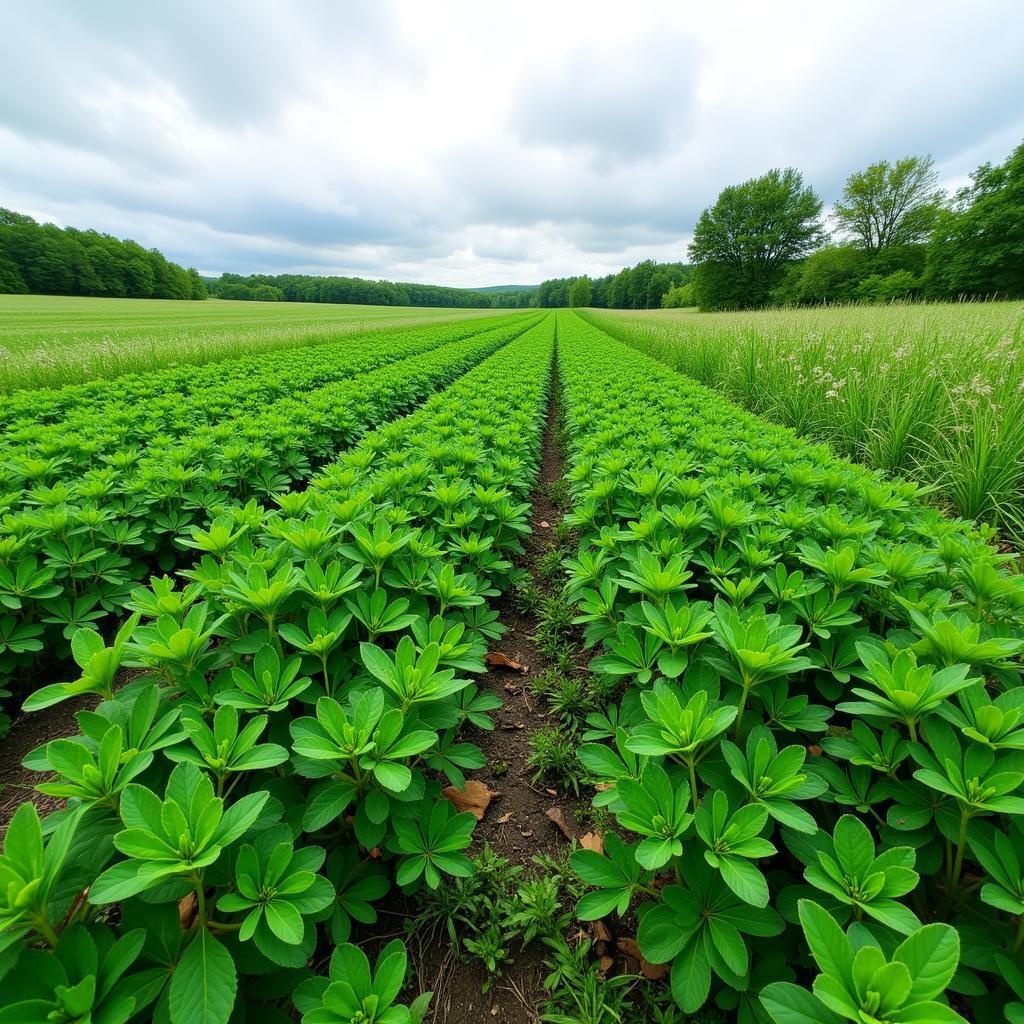Knowing When To Cut Clover Food Plots is crucial for maximizing their nutritional value for deer. Cutting clover at the right time encourages regrowth, prevents it from becoming too mature and less palatable, and helps control weeds. Timing this correctly can significantly impact the success of your food plot and the overall health of your deer herd.
Getting the timing right for cutting your clover food plots can feel like walking a tightrope, but it’s essential for providing deer with the best possible nutrition. After a successful first cutting, many food plot managers wonder about the best time for a second cut. Several factors influence this decision, including the type of clover you’ve planted, your local climate, and the overall goals you have for your food plot. Understanding these factors will allow you to tailor your cutting strategy for optimal results. Just a few weeks after planting your throw n grow food plot, you’ll likely start seeing results and need to plan your first cutting.
Factors Influencing Clover Cutting Time
Clover Variety and Growth Stage
Different clover varieties have different growth habits and maturity rates. White clover, for example, tends to grow more quickly than red clover. Observe your clover’s growth stage. Ideally, you want to cut it just before it starts to flower. This stage ensures maximum nutrient content and encourages robust regrowth. Waiting too long allows the plants to become woody and less desirable for deer. Cutting too early, on the other hand, may weaken the plants and hinder their ability to recover.
Climate and Weather Conditions
Your local climate plays a vital role in determining the optimal cutting time. In warmer climates, clover may grow rapidly and require more frequent cuttings. Cooler climates may necessitate a later first cutting and fewer cuts overall. Rainfall also affects growth. Adequate moisture promotes vigorous growth, while drought conditions can slow it down considerably. Pay close attention to local weather forecasts and adjust your cutting schedule accordingly. Dry periods may require postponing cutting to allow the plants to recover.
Food Plot Goals
Your specific goals for the food plot will influence your cutting strategy. Are you primarily focused on providing forage during the hunting season, or are you looking to maximize nutrition throughout the year? If your goal is to provide high-quality forage during the fall hunting season, you may want to time your final cutting so that tender regrowth is available when deer need it most. For plots focused on year-round nutrition, more frequent cuttings may be necessary to keep the clover in its most palatable and nutritious stage. Consider planting perennial deer food plots for a more consistent and long-term food source.
When Should You Make the Second Cut?
Generally, a good rule of thumb for the second cutting is 4-6 weeks after the first, depending on the growth rate and the factors mentioned above. “Observing your clover patch closely is key,” says Dr. Sarah Miller, a wildlife biologist specializing in deer nutrition. “Don’t rely solely on a calendar; watch for those telltale signs of robust growth and pre-flowering stages.” This advice underscores the importance of regular monitoring and adapting to the specific conditions of your food plot.
 Clover Growth Stages for Cutting
Clover Growth Stages for Cutting
Maintaining Healthy Clover Food Plots
Mowing Techniques
Proper mowing techniques are essential for promoting healthy regrowth. Set your mower height to leave at least 4-6 inches of stubble. This provides enough leaf area for photosynthesis and helps the plants recover quickly. Using sharp mower blades creates a clean cut, reducing stress on the plants. Dull blades can shred the clover, leaving it susceptible to disease. For smaller plots, a string trimmer can be effective, but ensure it’s equipped with a sharp blade. For a smaller plot, like a 1/4 acre food plot, you may find a string trimmer more manageable than a large mower.
Weed Control
Cutting clover also helps control weeds. Regular mowing prevents weeds from going to seed and competing with the clover for nutrients and sunlight. If you notice persistent weed problems, consider using a selective herbicide specifically designed for clover food plots. Always follow label instructions carefully when using any herbicides.
 Healthy Clover Food Plot after Cutting
Healthy Clover Food Plot after Cutting
Conclusion
Knowing when to cut clover food plots is a critical aspect of successful food plot management. By considering the clover variety, climate, your goals, and employing proper mowing techniques, you can ensure your food plot provides optimal nutrition for your deer herd throughout the year. Remember that regular monitoring and adaptation are crucial for achieving the best results. So, keep a close eye on your clover, and you’ll be well on your way to creating a thriving food plot that attracts and nourishes a healthy deer population. Choosing the right seed mix, such as perfect 10 food plot seed, can also contribute significantly to the success of your food plot.
FAQ
- How often should I cut my clover food plot? This depends on several factors, but generally, cutting every 4-6 weeks is a good starting point.
- What height should I cut my clover? Aim for a cutting height of 4-6 inches to allow for sufficient regrowth.
- Can I cut clover too often? Yes, cutting too frequently can weaken the plants and reduce their overall productivity.
- What should I do with the clover clippings after cutting? You can leave the clippings on the plot as a natural fertilizer.
- Will cutting clover attract more deer? Yes, fresh clover regrowth is highly attractive to deer.
- What if my clover starts to flower before I can cut it? It’s best to cut it as soon as possible to prevent it from becoming too mature and less palatable.
- Should I fertilize my clover food plot after cutting? Fertilizing after cutting can help promote healthy regrowth.
Common Scenarios and Questions
Scenario: My clover is growing rapidly due to excessive rain. Should I cut it sooner than planned? Yes, you can cut it earlier if it’s growing excessively fast. Monitor its growth stage to determine the optimal time.
Question: Can I use a brush hog to cut my clover? Yes, a brush hog can be used, but ensure it’s set to the correct height to avoid damaging the clover crowns.
Further Reading and Resources
For more information on food plot radishes, visit our food plot radishes page.
Contact Us
For assistance, please contact us at Phone Number: 02437655121, Email: minacones@gmail.com or visit our address: 3PGH+8R9, ĐT70A, thôn Trung, Bắc Từ Liêm, Hà Nội, Việt Nam. We have a 24/7 customer service team.